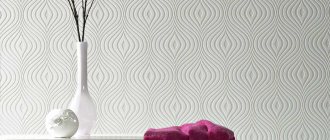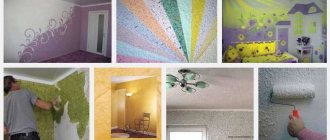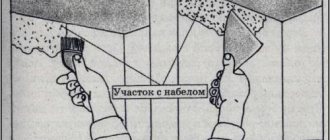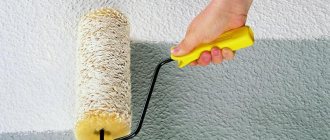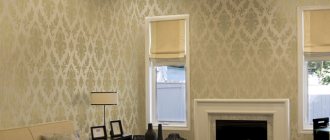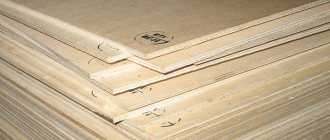Most people initially regard wallpaper as an extremely flammable material and do not have any special requirements for its fire resistance. But if this point of view may be true for residential premises, then for public buildings there are strict fire safety standards and regulations.
Because of these rules, for a very long time it was not allowed to decorate the walls of hospitals, restaurants and office buildings with wallpaper. But now there are wallpapers that, while retaining all the advantages of this type of finish, are nevertheless non-flammable, or at least resistant to fire.
Which wallpaper fully complies with fire safety standards? What are the advantages and disadvantages of fire-resistant wallpaper? Which coatings can be classified as fire retardant, and which ones are simply fire resistant? Our article is devoted to these and other issues.
Who needs fire-resistant wallpaper?
All finishing materials, including wallpaper, can be either non-flammable or flammable to varying degrees: slightly, moderately, normally and highly flammable. Therefore, we can talk about the fire resistance of wall decoration to the extent that it meets the needs of the owner of the premises and the safety standards applicable to such premises.
The general rule is this - the more people gather in a room, the lower the degree of flammability should correspond to them. Therefore, owners and managers of public buildings are primarily interested in fire-resistant wallpaper. These are schools, medical institutions, public buildings, sports facilities and other buildings where large gatherings of people are provided.
On the other hand, owners of private houses and residential premises in apartment buildings also pay attention to the flammability of the finish. With the proliferation of fire retardants in the form of sprays and impregnations, residential building structures are increasingly treated with fire-resistant compounds, so choosing a fire-resistant finish is the next smart step.
In this case, fire-resistant wallpaper is chosen not because of its compliance with the fire hazard class of the building, but because the owner of the premises cares about his own safety. And this issue can also be approached in different ways.
Fireproof or non-fireproof?
The fire resistance of building materials is indicated by KM coefficients with an index from 0 to 5, that is, from absolute safety (non-flammability) KM0 to severe fire hazard KM5. The fire hazard coefficient of a material, in turn, is a complex indicator, and it depends on a number of indicators:
- flammability;
- flammability;
- toxicity;
- the ability to spread flame over a surface;
- smoke generating ability.
That is, in order for wallpaper to have a low flammability, it is not enough that it ignites poorly in an open flame or under strong heat. It is also necessary that when burned they do not emit toxic gases and smoke, and that fire does not spread well over their surface.
The most common paper wallpapers, depending on whether they are glued to a non-flammable or combustible base, can be classified as either a highly fire-hazardous material or a moderately fire-hazardous material (KM3 - KM5). At the same time, for public buildings, fire safety requirements require wall finishing with materials with a coefficient from KM0 to KM3.
Types of fire-resistant wallpaper
Are there wallpapers that meet these requirements? Yes, modern industry produces roll wall coverings with increased fire resistance coefficients. These are both conventionally “household” and “professional” (requiring special skills for application) types of wall decoration.
The types of fire-resistant wallpaper can also be expanded through the use of special impregnation, which is discussed below, however, even with impregnation, the number of wallpapers that can be described as “fire-resistant” is limited:
- Glass wallpaper
The only wallpaper that not only meets the concept of fire resistance, but is a full-fledged fire-retardant coating is glass wallpaper. The basis of this type of finishing is glass fiber, which is made from quartz sand, dolomite, lime and soda. On special machines, fiberglass is woven into a dense canvas using a variety of weaving patterns.
Glass belongs to the class of non-combustible building materials, therefore fiberglass, the basis of glass wallpaper, retains these properties. Along with the fact that glass wallpaper is a non-flammable material, it also meets high environmental safety requirements.
However, it is necessary to ensure that other materials used for this type of finishing meet a high degree of fire resistance. First of all, this applies to primers and paints that are used to complete the finish.
Correctly selected components when decorating walls with glass wallpaper can make them completely safe from the point of view of fire hazard. They can be used to cover residential premises whose walls are very hot (in places where stoves, fireplaces are located, in kitchens, saunas, etc.), and can also be used in buildings that are intended for large gatherings of people and in evacuation areas.
- Cork wallpaper
The fire resistance of cork coatings depends on the basis on which they are made. A solid cork covering with a non-woven backing will be safer than paper-based wallpaper. Cork itself does not support the spread of fire, so solid cork coverings have a high degree of fire resistance. However, the base and the materials used for tinting can be highly flammable, so when choosing cork wallpaper (which is also expensive), you need to pay attention to the product conformity certificate and the materials used in the finishing (if we are talking about cork wallpaper for painting).
- Liquid wallpaper
Liquid wallpaper, depending on what components are used in its production, can have a variety of fire resistance, from high to medium. Typically, this is wallpaper made from various components, which include artificial silk, glue and artificial decorative inclusions, which give the finished surface structure and color (or shine).
When choosing liquid wallpaper with fire-retardant properties, you should pay attention to the certificate of conformity issued by the manufacturer for certain types of products. In addition, it is worth considering that liquid wallpaper:
- radically change color and sometimes structure under the influence of heating to high temperatures or an open flame;
- are not anti-vandal (which is unacceptable for places with a high degree of wear and tear, as well as for premises where pets are kept);
- are labor-intensive to apply and are expensive finishing materials.
This limits the use of such wallpaper in large rooms and reduces their attractiveness as a fire-resistant coating.
- Metallized wallpaper
Wallpaper with a top foil coating is a relative novelty on the building materials market. And due to the production technology and materials used, it is also a very expensive material. Such wallpaper, if applied to non-woven fabric (there is a paper-based option), will have impressive fire-resistant characteristics: it does not burn and does not support combustion.
However, based on the combination of other characteristics: high cost, low wear resistance, poor resistance of the metallized coating to damage and weak vapor permeability, wallpaper can hardly be considered a “first choice” material for finishing both public and residential premises.
- Non-woven wallpaper
Non-woven wallpaper is a low-flammable type of finish: up to fire hazard class KM3. They do not have such disadvantages as low vapor exchange or high labor intensity of application. However, their final fire resistance properties depend on the materials used for finishing (often such wallpapers are produced for painting). It is also worth noting that this type of finishing is expensive, and its anti-vandal properties are low. The service life of this type of finish is 10 years.
- Vinyl wallpaper on non-woven backing
Vinyl wallpaper on a non-woven backing can be considered limitedly fire resistant. Typically, this type of wall decoration corresponds to the KM3 fire hazard class, which allows them to be used in public spaces with a low level of crowded people. But the use of this type of wallpaper in residential buildings must take into account the fact that they “do not breathe,” that is, they limit the effective exchange of steam in the room. And this is fraught with a feeling of stuffiness and stuffiness, as well as the spread of fungi under the wallpaper.
- Fire retardant impregnations
One of the most provocative types of wall decoration is wallpaper with fire retardant impregnation. Modern industry produces such innovative liquids and sprays that, if properly processed, they can protect even initially highly flammable materials, such as paper wallpaper and wallpaper made from flammable synthetic materials, from fire. Certain types of paper wallpaper undergo fire retardant treatment in the factory.
Fire-retardant impregnations include fire-resistant paints, varnishes (unlike paints, they are colorless) and fire retardants - impregnations that are applied with a roller or spray, changing the flammability, smoke generation and toxicity properties of the finishing material being processed.
However, this solution has certain disadvantages and limitations:
- limited period of action of fire retardants (fire retardant impregnation must be renewed every 5-7 years);
- high cost (often, impregnation with fire retardants is used as an emergency when the finishing has already been done, but due to a mistake by the builders it does not correspond to the required fire resistance class);
- Fire-retardant finishing reduces the efficiency of vapor exchange, that is, the wallpaper stops “breathing.”
Wallpaper for the stove
They are made from special glass fiber, which under pressure and high temperature (1000-1200 C) takes the form of yarn of different thicknesses. Ready-made materials are used to make spider webs. The latter has the shape of a web and “reinforces” the glass wallpaper. Glass wallpaper for stoves is advantageous because it does not require unnecessary processing and transmits heat very well. Also, glass wallpaper can be painted with detergent paints and water-based paints. If we add high strength and heat resistance to these characteristics, we get a finishing material that has no analogues in its properties.
Finishing a stove with glass wallpaper is a targeted and step-by-step process in which glass wallpaper is correctly adhered to the surface of the stoves. Many people are afraid that when covering the furnace with glass fibers, the latter will burst or will not allow sufficient heat to pass through. However, in practice it is proven that they can be guaranteed to be used in oven finishing. They are also used along with other finishing materials.
Features of fire-resistant glass wallpaper Vitrulan
Fire-resistant glass wallpaper from the leading European manufacturer Vitrulan has all the advantages of fiberglass products. They are absolutely non-flammable, made from environmentally friendly materials and have a long service life. However, even in the line of glass wallpaper, Vitrulan wallpaper has distinctive properties that put it a step above the products of other manufacturers:
- Vitrulan fiberglass wallpaper is maximum care for the consumer
The Vitrulan line of glass wallpaper is represented by wallpaper with glue already applied (Aqua Plus collection), as well as a number of articles with a pre-finish coating (high-quality primer). Therefore, it is easy to paste such wallpaper, and there is no need to think about the characteristics of the adhesive base and wallpaper primer - their quality is always consistently high.
- Vitrulan fiberglass wallpaper – a great look for a long time
There is no need to limit yourself in design when choosing Vitrulan fire-resistant glass wallpaper. A variety of wallpaper patterns will allow you to decorate a room in any style, from classic to modern. The wallpaper can withstand up to 20 layers of paint without losing the original design, lasts longer than all other types of wallpaper and has excellent reinforcing and vandal-proof qualities.
- Vitrulan glass wallpaper – high quality and environmental standards
By choosing Vitrulan fire-resistant glass wallpaper, you are buying wall coverings that are unrivaled in quality and safety. With them there will be no problems with steam exchange, the wallpaper is easy to clean if it becomes dirty, including from heavy soiling. Glass wallpaper is hypoallergenic, like glass itself.
Choose Vitrulan glass wallpaper and you won't have to compromise between beautiful appearance and fire safety! Vitrulan glass wallpaper is the best solution for complete confidence in safety!
Non-flammable wallpaper and fabrics
Non-flammable fiberglass wallpaper
Fiberglass wallpaper is a new generation of modern fire-retardant materials.
Non-flammable fiberglass wallpaper is an environmentally friendly natural product. Fiberglass thread is made from natural raw materials: quartz sand, and fiberglass wallpaper is woven. Wall coverings made in this way have exceptional qualities. Fiberglass wallpaper is used in modern decoration of office walls, corridors of public buildings, bank premises, and shops.
Distinctive properties of glass wallpaper:
- Wallpaper is environmentally friendly, easy to use, does not absorb foam, and can be washed.
- Excellent resistance to deformation forces in walls, for example, from dry plaster.
- Using a special self-adhesive tape in the seams when painting, you can completely eliminate the visibility of the seams.
- Wallpaper is available in white and color, differing in density, durability, texture and pattern.
The basis of fiberglass wallpaper is fiberglass threads. These wallpapers come in two-layer (a fiberglass layer is pressed with a paper backing) and single-layer, with a smooth or corrugated surface. However, this pattern is not formed by embossing, but is woven when the fabric is produced.
After pasting, fiberglass wallpaper is painted with latex, water-based or acrylic paints. The result is a durable and wear-resistant coating that can withstand frequent brushing and can be repainted up to 10 times.
Fiberglass wallpaper has been used abroad for about 50 years, but such finishing material has been known to the Russian building materials market not so long ago, no more than 10 years. The production technology of this material is as follows: the wallpaper base, consisting of special glass fibers, is processed at a temperature of about 1200 degrees Celsius, and then spun into yarn and woven. The result is a woven fabric with different patterns. Using glass wallpaper to decorate old buildings, you can achieve structural and color unification of surfaces and give the premises a modern look.
The raw materials for the production of fiberglass wallpaper are mineral, environmentally friendly materials: quartz sand, soda, dolomite, which do not emit toxic substances into the air and do not cause allergies. Also, the positive properties of this wallpaper include the following:
- fire resistance;
- vapor permeability;
- waterproof;
- alkali and acid resistance.
Fiberglass wallpaper can be glued to concrete and brick surfaces, drywall, chipboard, fiberboard, free of dust and other contaminants, as well as to wooden and metal bases. The structural surface of glass wallpaper helps to mask small wall defects, cracks and seams between panels.
Flame retardant fabrics
Fire protection of fabric is an extremely important process in everyday life, since fabrics not treated with fire retardant compounds (solutions) are very susceptible to fire, smoldering and further spread of fire in the room.
Currently, flame retardant (i.e., fireproof) fabrics woven from special fibers are widely used. These fibers are a modified polyester, the flame resistance of which is due to the molecular structure of the material. Therefore, fabrics made from this fiber constantly retain their fireproof properties during many years of use, despite repeated washing, cleaning, increased loads, etc.
Modern weaving technologies make it possible to create from such fibers the entire range of curtain and upholstery fabrics - from the finest veils to dense velor and flocks. Therefore, designers now have many different types of fabrics, using which you can decorate interiors of any complexity and in any style. Fabrics made from such fibers are extremely light-resistant, hygienic, do not cause allergies and do not contain harmful substances.
Where are flame retardant fabrics most often used? First of all, these are public spaces - hospitals and nursing homes, kindergartens and schools, theaters and concert halls, cafes and restaurants, hotels and casinos. These fabrics are widely used in interior decoration in transport: chairs and interior decoration of buses and cars, in airplanes and railway cars.
We think that no one will mind if the interior of a residential building contains objects that are difficult to ignite. Moreover, the choice of such fabrics is large: from curtains and furniture upholstery to bed linen.
The undeniable advantages of non-flammable fabrics:
- A large assortment of fabrics, wide possibilities for their use: fabric curtains, tulle, bedding, roller fabric blinds, vertical blinds, window and balcony awnings, movable indoor screens, furniture fabrics, fabrics for covering walls;
- Fabrics that are easy to care for do not wrinkle and retain their shape and size;
- A short cycle of washing fabrics at low temperatures saves water, detergents and electricity;
- Fabrics are resistant to any disinfectants;
- The fabrics have rich colors and light fastness;
- The fabrics have high abrasion resistance;
- Furniture fabrics are extremely comfortable due to excellent breathability;
- Flame-resistant fibers and threads do not cause allergies and do not contain substances harmful to health.
- Fabrics are not susceptible to rotting and mold;
- Fire retardant properties are achieved through chemical modification of polyester molecules, which are not affected by either long service life, frequent washing, or natural aging of the material;
- Fire retardant properties are always preserved in fabrics without additional treatment with special means;
- In the event of a fire, there is no smoldering on the fabrics; smoke is produced in very small quantities;
- Constant quality control of existing fabrics and the procedure for admitting new brands of fabrics to market guarantee the reliability and safety of their use;
- All product brands have verification certificates;
- An equally high level of product quality is ensured by continuous quality control during the production process;
- Fabrics are used not only in office or commercial premises, they are ideal for use in the private or home sphere.
Materials for processing fabrics
Today, the most promising and affordable fire retardant impregnations for fabrics and carpets can be considered fire-resistant biopyrenes of the “Nortex” brand:
- "Nortex-KP" - used for fire retardant and antiseptic treatment of synthetic and wool blend carpets;
- "Nortex-S" - used to protect against fire and increase the antiseptic properties of mixed fabrics;
- "Nortex-X" - used for fire protection and increasing the antiseptic properties of cotton fabrics, as well as for impregnating cardboard and paper;
- "Nortex-Sh" - used to protect against fire and increase the antiseptic properties of woolen and half-woolen fabrics.
There are also other types of fire-resistant impregnating compounds on the fire protection market, including those applied to fabric products by spraying with a spray bottle.
Next →
← To previous section
← To the beginning of the article

